
Ever since I can remember, I have had a passion for growing tomatoes. The diversity of colours and flavours of their fruit, the delicate ferny foliage of the young plants, even the resinous, green smell of the leaves, all bring me joy. However, there is one thing about these plants that is a constant source of frustration, particularly at this time of year: their infuriatingly slow ripening. As we edge towards the end of the growing season, here are a few tips and tricks to speed up their maturity.
Hailing from the eternal summer of the tropical Andean highlands, tomatoes have never evolved the chemical triggers to hasten ripening as days shorten and temperatures dip. This means that plants will continually attempt to kick out more flowers and fruit right until they are cut down by frost before they ripen. Knowing this, gardeners need to step in and stage a horticultural intervention to stop this self-destructive behaviour. All you need to do is pinch out the top of your tomato plant once it has produced four trusses (bunches) of fruit, preventing it from growing any taller or bearing more flowers. If your plants are already significantly larger than this, pinch out their growing tip no matter the height and remove all green fruit that haven’t reached their mature size.
Without their resources being wasted on producing fruit, the plants will be better able to focus their efforts on ripening what they have already produced. Another upside is that trials have repeatedly shown that reducing the number of fruit not only hastens the ripening of tomatoes, but also improves the flavour, size and nutrient content of the harvest. A perfect win-win.
Another way to channel the plants’ energies into ripening fruit is to induce stress. Sensing their survival may be at stake, the plants will respond by speeding up the maturation of their fruit, to ensure the future of the next generation via their seeds. This can be done by gradually reducing the amount you water them. It is important to do this slowly to give the plants time to adapt, as erratic watering can cause harvest deformities such as split fruit (too much water) or blossom end rot (too little). The same thing goes for fertiliser, which is usually added to the irrigation water. The even better news is that this lower water and fertiliser regimen has also been shown by studies to improve fruit flavour.
Finally, as we get to the very end of the season, one sure-fire way to induce this stress is to hamper water absorption via root trimming. I usually do this in mid-September, but timing will vary depending on your local climate. Simply slice into the soil around the plant with a spade about 50cm away from the main stem, which will sever the outermost roots. Work your way round until you have a ring around each plant.
Faster ripening, less waste, better-flavoured fruit and even more nutritious harvests in exchange for just a little pruning and being lazier with the watering can is a pretty sweet deal.
Follow James on Twitter @Botanygeek
The Link LonkAugust 30, 2020 at 02:15PM
https://ift.tt/2ENhUnT
Three easy ways to ripen your tomatoes - The Guardian
https://ift.tt/2VAxJ6V
Tomato

No comments:
Post a Comment